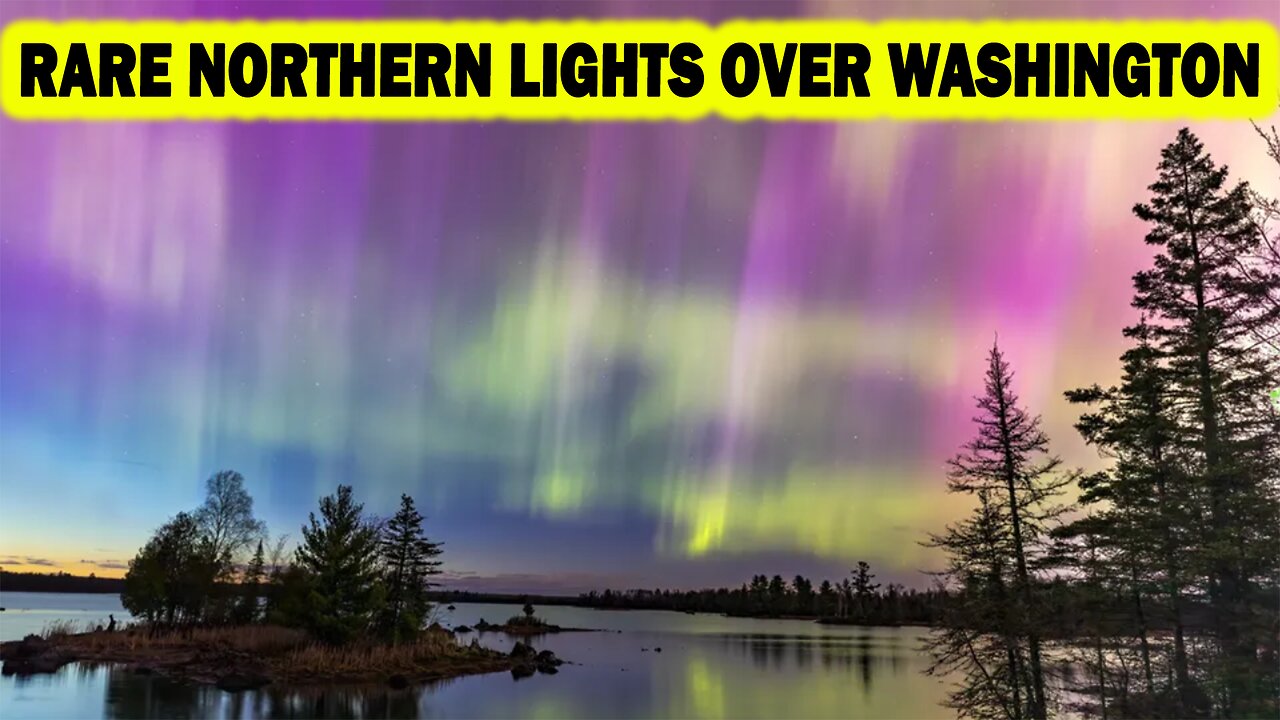Premium Only Content

Aurora Borealis Over Washington! Rare Northern Lights with Maps | June 2025 Solar Storm | newsdrift
Witness the rare and stunning Aurora Borealis that lit up the skies over Washington State on June 1, 2025! 🌌 In this video, we explain what caused this incredible northern lights display, how a powerful G4 solar storm triggered it, and where it was visible using real-time aurora forecast maps.
Discover the science behind coronal mass ejections (CMEs), geomagnetic storms, and how solar activity can make the aurora visible far beyond the Arctic Circle—even in places like Seattle, Skagit County, and the Pacific Northwest.
📍 Topics Covered:
What caused the June 2025 aurora
How solar storms affect Earth’s magnetosphere
Real aurora visibility maps from NOAA
Best places and times to see northern lights
How to catch the next aurora event near you
Stay updated on future space weather events and learn how to spot auroras from your own backyard!
🔔 Don’t forget to like, comment, and subscribe for more skywatching videos!
#AuroraBorealis #NorthernLights #WashingtonAurora #SolarStorm2025 #AuroraForecast #SpaceWeather #NOAA #G4Storm #CME #Skywatching #June2025 #AuroraMaps
CNN, Fox News, MSNBC, ABC News, NBC News, CBS News, PBS NewsHour, Bloomberg News, CNBC, The New York Times, The Washington Post, NewsNation, Reuters, Associated Press, USA Today
But what caused this unexpected display? Why was the aurora visible so far south, and where might it be seen next? In this video, we’ll break down the science behind this dazzling event, how a powerful solar storm made it happen, and what you can do to catch the next one—even if you don’t live near the Arctic Circle.
Let’s start with what happened. On Friday, May 30th, a powerful coronal mass ejection, or CME, erupted from the sun. A CME is a huge burst of solar plasma and magnetic field that gets ejected into space. When one of these bursts heads directly toward Earth, it slams into our planet’s magnetosphere, the protective magnetic field that surrounds Earth. That impact causes a geomagnetic storm.
In this case, the storm was rated G4 on a scale from G1 to G5. That’s severe. And severe geomagnetic storms have a strong chance of pushing the aurora farther south than usual. Normally, you’d have to be in Alaska, Canada, or northern Scandinavia to see the northern lights. But during a G4 storm, the aurora can dip down into the northern United States—and that’s exactly what happened.
Maps from the NOAA’s Space Weather Prediction Center showed the auroral oval expanding dramatically during the storm. For a few hours on Sunday night, parts of Washington, Oregon, and even some inland states lit up in green, purple, and red hues.
Reports came in from all over western Washington. People in Seattle, Skagit County, Clallam County, and even the Tri-Cities area shared photos and videos of the glowing sky. Some described it as otherworldly, while others were surprised they could see it right from their backyard.
The National Weather Service confirmed that the CME had reached Earth, interacting strongly with the magnetosphere. This interaction stirred up intense solar wind conditions and made the aurora visible to millions of people who normally don’t get the chance to see it.
But there’s more. Forecasters warned that although the activity was expected to ease by Monday evening, the situation could change rapidly. If the magnetic orientation of the solar wind shifted southward again, the aurora could return with similar strength.
That’s why real-time monitoring is important. NOAA’s Space Weather Prediction Center offers updates on solar activity and aurora forecasts, including maps showing where visibility is likely. If you’re hoping to catch the aurora in your area, your best chance is to check these maps during geomagnetic storm alerts.
Experts also recommend heading away from city lights to avoid light pollution. The darker your surroundings, the more vivid the aurora will appear. Wide, open areas with a clear view of the northern horizon give you the best shot.
This stunning display wasn’t a one-time event either. The sun follows an 11-year solar cycle, with periods of high activity known as the solar maximum. Right now, we are in the peak of that cycle, which means more CMEs and more opportunities for auroras to reach farther south.
So, what should you do if you missed it? First, don’t worry—more solar activity is expected in the coming months. Keep an eye on aurora forecast maps, especially when space weather agencies issue G3, G4, or G5 storm warnings. Subscribe to alert services or install apps that notify you in real time.
If conditions look favorable, grab your camera, head out of town, and look up. You might just get lucky enough to witness one of nature’s most mesmerizing light shows—no plane ticket to the Arctic required.
Thanks for watching, and don’t forget to subscribe for more updates on space weather, skywatching tips, and natural wonders happening right above us.
-
 LIVE
LIVE
Camhigby
2 hours agoLIVE - Riot Watch Portland, DC, NC
181 watching -
 2:54:58
2:54:58
CAMELOT331
4 hours agoYouTube Just Told Me I OWE THOUSANDS $ TO THEM... update
12.6K -
 LIVE
LIVE
Tundra Tactical
11 hours ago $0.60 earned🛑LIVE AT 9PM CST!! Your Government Hates Your Guns : DOJ Holds Firm On National FIREARMS ACT
104 watching -
 LIVE
LIVE
DLDAfterDark
2 hours ago $0.59 earnedAre YOU The Guy That Ruins Thanksgiving?? - God Guns & Gear
171 watching -
 2:58:31
2:58:31
NewsTreason
3 hours agoDECLAS w/ Rambo & Dave: Nuremberg 2.0 | MTG Exits Stage Left | Mamdani Psyop Confirmed, 8pm EST
53.4K51 -
 LIVE
LIVE
meleegames
3 hours agoSONG REQUESTS CLOSED - Melee Music - Beat Hazard 3 - Devil Inside
108 watching -
 LIVE
LIVE
The Connect: With Johnny Mitchell
10 hours ago $1.28 earnedIs Garth Brooks A Serial Killer? Exposing The Dark Secrets Of Country Music's Biggest Star
236 watching -
 1:00:49
1:00:49
MattMorseTV
4 hours ago $76.40 earned🔴Massive VICTORY in the SUPREME COURT.🔴
97.4K120 -
 LIVE
LIVE
GritsGG
3 hours ago#1 Most Warzone Wins 4015+!
74 watching -
 4:20:08
4:20:08
Biscotti-B23
6 hours ago $0.95 earned🔴 LIVE STREAM ENDS WHEN I GET 100 WINS 🥵 INVINCIBLE VS CLOSED ALPHA
10.2K3